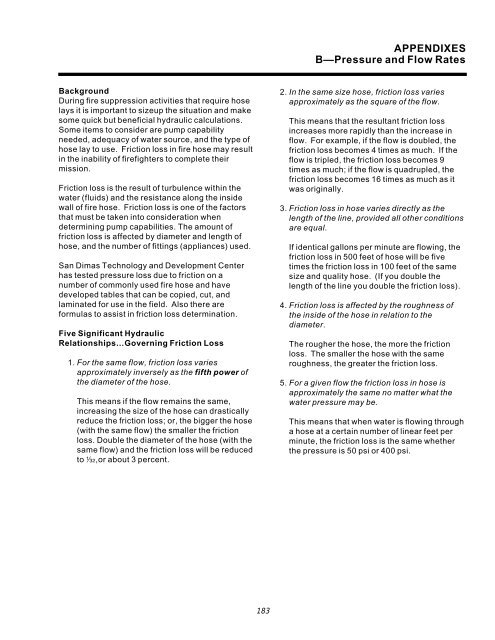Water Handling Equipment Guide - National Wildfire Coordinating ...
Water Handling Equipment Guide - National Wildfire Coordinating ...
Water Handling Equipment Guide - National Wildfire Coordinating ...
You also want an ePaper? Increase the reach of your titles
YUMPU automatically turns print PDFs into web optimized ePapers that Google loves.
APPENDIXES<br />
B—Pressure and Flow Rates<br />
Background<br />
During fire suppression activities that require hose<br />
lays it is important to sizeup the situation and make<br />
some quick but beneficial hydraulic calculations.<br />
Some items to consider are pump capability<br />
needed, adequacy of water source, and the type of<br />
hose lay to use. Friction loss in fire hose may result<br />
in the inability of firefighters to complete their<br />
mission.<br />
Friction loss is the result of turbulence within the<br />
water (fluids) and the resistance along the inside<br />
wall of fire hose. Friction loss is one of the factors<br />
that must be taken into consideration when<br />
determining pump capabilities. The amount of<br />
friction loss is affected by diameter and length of<br />
hose, and the number of fittings (appliances) used.<br />
San Dimas Technology and Development Center<br />
has tested pressure loss due to friction on a<br />
number of commonly used fire hose and have<br />
developed tables that can be copied, cut, and<br />
laminated for use in the field. Also there are<br />
formulas to assist in friction loss determination.<br />
Five Significant Hydraulic<br />
Relationships…Governing Friction Loss<br />
1. For the same flow, friction loss varies<br />
approximately inversely as the fifth power of<br />
the diameter of the hose.<br />
This means if the flow remains the same,<br />
increasing the size of the hose can drastically<br />
reduce the friction loss; or, the bigger the hose<br />
(with the same flow) the smaller the friction<br />
loss. Double the diameter of the hose (with the<br />
same flow) and the friction loss will be reduced<br />
to œ,or about 3 percent.<br />
2. In the same size hose, friction loss varies<br />
approximately as the square of the flow.<br />
This means that the resultant friction loss<br />
increases more rapidly than the increase in<br />
flow. For example, if the flow is doubled, the<br />
friction loss becomes 4 times as much. If the<br />
flow is tripled, the friction loss becomes 9<br />
times as much; if the flow is quadrupled, the<br />
friction loss becomes 16 times as much as it<br />
was originally.<br />
3. Friction loss in hose varies directly as the<br />
length of the line, provided all other conditions<br />
are equal.<br />
If identical gallons per minute are flowing, the<br />
friction loss in 500 feet of hose will be five<br />
times the friction loss in 100 feet of the same<br />
size and quality hose. (If you double the<br />
length of the line you double the friction loss).<br />
4. Friction loss is affected by the roughness of<br />
the inside of the hose in relation to the<br />
diameter.<br />
The rougher the hose, the more the friction<br />
loss. The smaller the hose with the same<br />
roughness, the greater the friction loss.<br />
5. For a given flow the friction loss in hose is<br />
approximately the same no matter what the<br />
water pressure may be.<br />
This means that when water is flowing through<br />
a hose at a certain number of linear feet per<br />
minute, the friction loss is the same whether<br />
the pressure is 50 psi or 400 psi.<br />
183
















